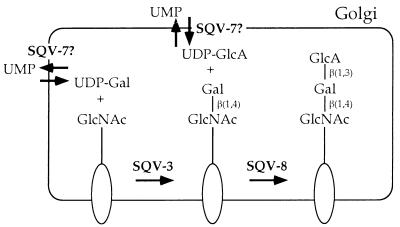Figure 4.
A model for sqv gene function. SQV-3, SQV-7, and SQV-8 may catalyze the formation of an oligosaccharide on one or more glycoproteins, glycolipids, or proteoglycans. The oval represents a glycoprotein, glycolipid, or proteoglycan, the longer straight line an oligosaccharide of unspecified structure, and the shorter straight lines sugar-sugar linkages. The biochemical activities proposed for SQV-3, SQV-7, and SQV-8 are based on a subset of those defined for the proteins related to them in amino acid sequence (see text). The terminal oligosaccharide is depicted as an unsulfated version of the HNK-1 epitope but instead may be less closely related to this epitope, may be further modified by the addition of sugars and/or sulfate groups, or may occur as a repeating rather than terminal unit (see text).

